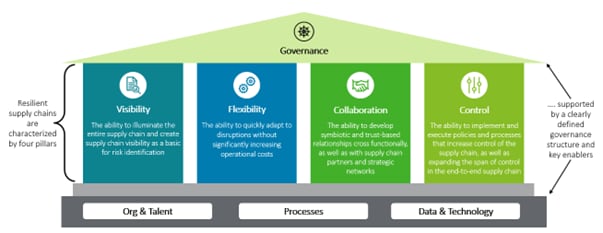Insight

Building Resilient Supply Chains: A Multi-dimensional Approach
Building a resilient supply chain is crucial in today's complex and volatile business environment. To achieve this, operations must invest in the four pillars of resilience: Visibility, Flexibility, Collaboration, and Control.
Rather than small, neatly organised linear supply
chains that are relatively easy to trace and understand, most supply chains
today are a mosaic of interdependent actors that require complex analysis to
figure out. The inability to illuminate supply chains often leaves
vulnerabilities hidden in the complexity. Add to this the global volatility and
the rising strategic competition between leading trade partners, and the need
to rethink supply chains becomes increasingly clear.
With a series of disruptive supply chain events over
the past decade, the impact is felt across the globe. Events such as Brexit,
the pandemic, the blocking of the Suez Canal, the climate crisis and Russia’s
war against Ukraine are felt across the globe trough impacts such as material
shortage, high inflation rates, and logistics capacity shortage.
Resilience a major theme now and in the future
In late 2022, we asked Deloitte’s Supply Chain Panel about their top priorities in 2023. Their answers confirmed a very strong focus on resilience, where more than 3 of 4 respondents value resilience in their operation as important. You can read the full report here. Similarly, 67% of respondents in Deloitte’s annual “Supply Chain trends & Priorities Survey 2023”, conducted in collaboration with IDA Operations Management, rate that they experience a need for increased supply chain resilience in their operation.
However, supply chain resilience is not one-dimensional. To create a resilient operation, you must invest in all four of the pillars of resilience: Visibility, Flexibility, Collaboration, and Control. Additionally, you must secure a strong foundation within your talent development, your processes, and your data & technology.

More insights into resilience enablers in the supply chain can be read in the report.
No journeys towards resilience look the same
Your journey towards supply chain resilience will depend on many factors, such as your success criteria and your baseline. However, tools such as Advanced Planning and Scheduling (APS) solutions or Integrated Business Planning (IBP) processes can take you a long way.
- For many companies, technology advancements, such as an APS solution, can help improve both internal and external supply chain management through better connectivity, visibility, and collaboration. Among Deloitte’s clients, we are already seeing holistic strategies that leverage the latest APS solutions by integrating sales, marketing, and procurement with supply planning to rapidly assess the impact of business decisions, evaluate what-if scenarios, and perform root cause analysis to identify improvement opportunities.
- Given that IBP is a collaborative process where tactical plans across a portfolio, customers, and production- (or service-) resources are aligned and calibrated against business aims, it can be a considerable boost for resilience. Simultaneously, risk and opportunity are discovered and assessed in scenarios, giving the executive team a clear picture of the business's status and the chance to decide how to keep it on course and in line with strategic objectives.
A multidimensional approach
Delivering capabilities to build resilience demands an updated approach to planning that pulls together a wider range of stakeholders to improve speed, flexibility, and responsiveness throughout the supply chain network. This requires embracing a comprehensive transformation that encompasses various enablers and strategies, while instilling a resilience mindset within the workforce.
While business processes are key to sustaining capabilities, businesses recognize the pivotal role of technology as a critical building block of a comprehensive solution. By leveraging advanced technological tools and platforms, organizations can enhance their operational efficiency, visibility, and real-time decision-making capabilities.
When these two crucial elements, namely technology and business process planning, converge within an organization ready for change, remarkable transformations occur. With the right tools, processes, and mindset, businesses can build a robust and adaptable supply chain network capable of withstanding disruptions, seizing new opportunities, and delivering exceptional value to customers – a true multidimensional approach.

